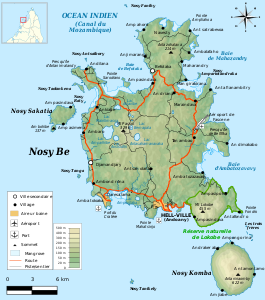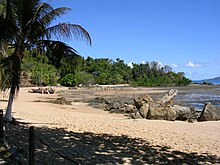Nosy Be
| Nosy Be | ||
|---|---|---|
| Satellite image of the island | ||
| Waters | Indian Ocean | |
| Geographical location | 13 ° 20 ′ S , 48 ° 15 ′ E | |
|
|
||
| length | 26 km | |
| width | 20 km | |
| surface | 325 km² | |
| Highest elevation | Lokobe 450 m |
|
| Residents | 60,000 185 inhabitants / km² |
|
| main place | Andoany | |
| map | ||
Nosy Be , formerly also known as Assada or Nosy Manitra , is an island off the coast of Madagascar . Her name means "big island" in Malagasy .
geography
The island, about 10 km off the northwest coast of Madagascar, is of volcanic origin . Nosy Be is about 325 km², the north-south extension is about 26 km and the east-west extension is around 20 km. It belongs to the province of Antsiranana , the island capital is the colonial Andoany (old and still common name today: Hell-Ville). The climate is humid and warm, the temperatures are between 25 and 30 ° C and do not drop below 21 ° C even in winter. The precipitation is around 2000 mm per year. Nosy Be has its own microclimate, even in the dry season it often rains, mostly at night, which makes for a lush green. Due to its location close to the Kalmengürtel the island has correspondingly little wind. Nevertheless, there are occasional cyclones in winter .
In the Lokobe nature reserve , which was established in 1923 and is 740 hectares in size, there is still the original primary tropical rainforest with the giant trees Canarium madagascariense and Potameia crassifolia , which can grow up to 40 m. The highest mountain at 450 meters is the Lokobe. In the volcanic craters, eleven crater lakes have formed, in which crocodiles live. The most important of the inhabited secondary islands is Nosy Ambariovato , also called Nosy Komba lemur island . The island opposite the Lokobe peninsula consists of a circular 621 m high volcano , which is almost completely covered by forest and plantations . Other small side islands are Nosy Mitsio , Nosy Sakatia and Nosy Tanikely.
population
The island has around 60,000 inhabitants, most of whom belong to the Foko of the Sakalava . The crater lakes are regarded by the population as the home of their ancestors and are therefore sacred. "Fadys" (prohibitions) must be observed: Whoever wants to approach them has to go barefoot, is only allowed to wear a swaddle and not to wear a headgear.
history
The first inhabitants of the island were Swahili and Indian traders in the 15th century . Later on, Nosy Be, then known as Assada, attracted refugees and traders. An English base was abandoned in 1649. In 1839 Tsiomeko, the last queen (1828–1843) of the kingdom of Bonia in the north-west of Madagascar, fled to Nosy Be. Bonia was annexed by the Merina Kingdom under Ranavalona I in 1840 . Tsiomeko had ceded her claims, including those of Nosy Be, to France.
From 1824 to 1846 around 15,000 Sakalava fled the fighting with the Merina to Nosy Be. In 1842 the island was occupied by France. It profited as a trading post on the way to Zanzibar . An uprising of the Sakalava in 1848/49 against the attempt by the French to abolish the slave trade meant a brief economic setback for Nosy Be. In order to persuade the escaped traders to return, the island was declared a free port by France.
During the Russo-Japanese War , the Second Russian Pacific Squadron, under the command of Admiral Zinovi Petrovich Roschestvensky, was forced to make an involuntary stop at Nosy Be to relieve the Russian forces trapped in Port Arthur because of urgent repairs. With the permission of France, 25 warships with almost 10,000 sailors and escort ships lay for weeks in the Bay of Hell-Ville, waiting for reinforcements from the Third Russian Pacific Squadron under Admiral Nikolai Ivanovich Nebogatow .
The bay in which the fleet anchored is now called "Russian Bay". During the waiting period, diseases broke out on the ships and a leaky transport ship sank. Some perished Russian sailors were buried in the Hell-Ville cemetery, while others were buried at sea in front of the bay. A war memorial on the island commemorates this. Other unconfirmed reports say that a ship was abandoned, the last of the forgotten sailors not dying until 1936. The transport ships Malaya and Prince Gorchakov were sent back to Russia with offenders, sick people, self-mutilators and the mentally ill. The incoming news of St. Petersburg's Bloody Sunday and the Russian defeat in the Battle of Mukden demoralized the Russian sailors. The events of these weeks apparently also served as a model for the song We lay before Madagascar . However, there is no conclusive evidence of a connection.
economy
The island is considered to be the best developed tourist destination in Madagascar. There are several hotels of western standard on Nosy Be, with a total of 350 guest rooms. Fascene Airport in the east of the island offers connections to the capital Antananarivo , Milan , Rome , Paris , the Comoros and Réunion . However, the development of tourism is hampered by the lack of infrastructure and a strong increase in crime . Even sex tourism was a problem.
Sugar cane fields , spice plantations for vanilla , cloves , pepper , ylang-ylang and cinnamon and subsistence farming characterize agriculture on the fertile volcanic soil. The sugar industry was restructured by Chinese investors at the end of 2007 . The production capacity could be increased to 16,000 tons of sugar and 11,000 hectoliters of alcohol per year. The rum of the same name was produced in Dzamandjary on the west coast.
The sugar cane fields and the rum distillery no longer exist today.
Climate table
| Nosy Be | ||||||||||||||||||||||||||||||||||||||||||||||||
|---|---|---|---|---|---|---|---|---|---|---|---|---|---|---|---|---|---|---|---|---|---|---|---|---|---|---|---|---|---|---|---|---|---|---|---|---|---|---|---|---|---|---|---|---|---|---|---|---|
| Climate diagram | ||||||||||||||||||||||||||||||||||||||||||||||||
| ||||||||||||||||||||||||||||||||||||||||||||||||
|
Average monthly temperatures and rainfall for Nosy Be
Source: wetterkontor.de
|
|||||||||||||||||||||||||||||||||||||||||||||||||||||||||||||||||||||||||||||||||||||||||||||||||||||||||||||||||||||||||||||||||||||||||||||||||||||||||||||||||||||
Web links
- Nosy Be in the Global Volcanism Program of the Smithsonian Institution (English)
Individual evidence
- ↑ Nosy Be on Madagascar Info and Nosy Be on Madainfo.de ( memento of the original from October 19, 2008 in the Internet Archive ) Info: The archive link was inserted automatically and has not yet been checked. Please check the original and archive link according to the instructions and then remove this notice.
- ↑ Nosy Be on weltbummeln.de and Nosy Be on Madainfo.de ( memento of the original from October 19, 2008 in the Internet Archive ) Info: The archive link was inserted automatically and has not yet been checked. Please check the original and archive link according to the instructions and then remove this notice.
- ↑ Madagascar - Indian Ocean ( Memento of the original from October 28, 2008 in the Internet Archive ) Info: The archive link was inserted automatically and has not yet been checked. Please check the original and archive link according to the instructions and then remove this notice. and Nosy Be on weltbummeln.de
- ^ Gemma Pitcher, Patricia C. Wright: Madagascar & Comoros . Lonely Planet, Footscray 2004, ISBN 1-74104-100-7 , p. 154.
- ^ Gwyn Campbell, An economic history of imperial Madagascar, 1750–1895 The rise and fall of an island empire . Cambridge Univ. Press 2005, ISBN 978-0-521-83935-8 , pp. 157 and 173f.
- ↑ Neal Bascomb: Red mutiny. Mutiny, revolution and revenge on the Battleship Potemkin . Weidenfeld & Nicolson Verlag, London 2007, ISBN 978-0-297-84648-2 , p. 7.
- ↑ Pierre Van Den Boogaerde: Shipwrecks of Madagascar. Strategic Book Publishing, 2008, ISBN 9781606934944 , p. 244.
- ↑ a b c Alexej Silytsch Novikow-Priboj : Tsushima. Military Publishing House of the GDR, Berlin 1986, ISBN 3-327-00251-7 , pp. 162-210.
- ↑ picture of the monument
- ^ Lutz Seiler, Anne Duden, Farhad Showghi: Heimaten . Wallstein-Verlag, Göttingen 2001, ISBN 3-89244-464-1 , p. 27.
- ^ Travel warning from the French Foreign Ministry
- ↑ Nosy Be on Madagascar Info and Nosy Be on weltbummeln.de
- ↑ La capacité de production pourra être retrouvée.



